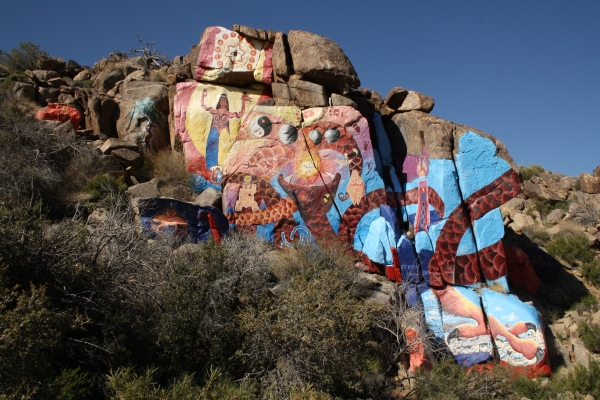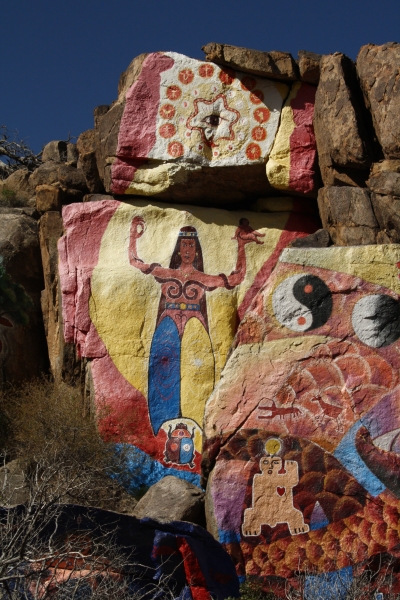Chloride between ghost town and artist community
It is hard to wrap your head around Chloride. Around this old village in Northern Arizona, the last echo of a mining boom died long ago, yet it's no ghost town, still boasting 250 residents. But it's not your stereotypical small town either, for individualism runs rampant and there's even some important public art here. It defies definition, and that's all the more reason to spend a few hours experiencing it.
Chloride is best known for its complex of murals, located in a quiet canyon in the foothills of the Cerbat Mountains east of town. With a high-clearance four-wheel-drive vehicle you can drive almost up to them but it's really more enjoyable to just drive to the point where the road becomes too challenging for an ordinary car, and walk the rest of the way.
You won't see the murals until you are upon them as they lie around a bend in the canyon. The artwork covers about 2,000 square feet of granite boulders and cliff faces. The artist, Roy Purcell, labeled these murals, "The Journey: Images From an Inward Search for Self." To understand the murals, Purcell told me you need to read them right to left. They are richly colored and full of recognizable objects, but portrayed in contexts not easily understood unless you were able to go back some 40 years ago into Purcell's mind at the time. The first mural depicts the Tennessee Mine and is enjoyable yet the one immediately to the left depicts a large claw which seems to be destroying the mine.
The Tennessee Mine was the largest in the area and produced 7.5 million dollars in gold, lead and zinc before it closed in 1947. Purcell painted the murals depicting it in 1966, retouched the color of the murals in 1975, and then vibrantly repainted them again in 2006, in honor of his 70th birthday.
Besides seeing the murals there is plenty of other art in town, albeit some of it quite funky. The best way to see Chloride is parking your vehicle and setting out on foot. Look closely at the private residences and you'll see homemade yard art in front of many. Some front yards showcase collections of bottles, cowboy boots or license plates while others are full of old farm and mine machinery.
Because times got slow in Chloride, there wasn't much reason to tear down older buildings to make way for new ones, so a high percentage of those still standing are historic in some way or another, and nearly all bear the aura and charm of earlier times. So you don't miss any of the historic buildings, be sure to pick up a free map at the Mineshaft Market, located on the main drag of town at 4940 Tennessee Avenue, which serves as the town's visitor center. You'll certainly want to see the abandoned two-room jail, built in the 1890s, and the train depot, which served the spur line of the Santa Fe Railroad line from Kingman and was used from 1898 to 1935. The famous Butterfield Stage came through here as well and ran from 1868 through 1919, stopping at what is now Yesterday's Restaurant. The old bank building is also worth seeing as well as the vintage gas station.
There are a few great antique and gift shops in town as well as a silversmith, and Yesterday's Restaurant is an excellent place to eat. They serve good home cooking, with a wide variety of food choices that appeal to all ages, including children.
Directions to Chloride
From Pahrump take NV-160 south about 52 miles to Las Vegas.
Merge onto I-215 east and drive about 12 miles.
Merge onto US-93 south and drive about 74 miles, passing through Boulder City and crossing into Arizona.
Turn left at County Highway 125 and go 3.7 miles to Chloride.
Directions to Chloride Murals
From the Chloride town center drive up Tennessee Avenue, which turns into gravel after about 0.5 miles.
If you don't have a high-clearance vehicle with good off-road tires, or there has been recent rain, park here and walk.
If you have such a rugged conveyance, drive 200 yards farther, crossing over a wide rocky wash and go right at the fork.
Follow this for about one mile staying left at the next fork.
After about 50 yards farther look for the parking pullout on the right, which serves as the best parking area.
Walk up the gravel road about 0.25 miles to murals located on the right.
Deborah Wall is the author of "Base Camp Las Vegas, Hiking the Southwestern States," "Great Hikes, A Cerca Country Guide," and co-author of "Access For All, Touring the Southwest with Limited Mobility." Wall can be reached at Deborabus@aol.com.

















